We came home from a ten day trip and found our jade plant looking pretty pathetic having dropped many leaves and branches. Maybe after twenty years it thinks it needs to go on a diet? Or, maybe we are doing something wrong with its care? After being prideful of the jade in a previous post, we just now might be in for a fall. Anyway, we figured we better spell out before it checks out of this life. Jade, Crassula ovata, is a member of the Crassulaceae family. According to myEtymology, the generic name Crassula is derived from the Classical Latin word crassus meaning, fat, stout, rue, thick, deep; deep coated. The specific name ovata likely refers to the oval-shapped leaves.
Pages
Tuesday, January 31, 2012
Binomen Art - Crassula ovata
Monday, January 30, 2012
Binomen Art - Sporobolus virginicus
Beach Dropseed, Sporobolus virginicus, is a grass common throughout tropical regions and native to the Pacific Islands Region. Despite what the common name might conjure up, the USDA Fact Sheet for this grass says that though S. virginicus produces seed, very little of it is viable and propagation by vegetative rhizomatous slips being the only practical method. However, the generic name, according to CRC - Plant Names, comes from the Greek spora, sporos “seed, spore” and ballo, bolis, bolos “casting” and referring to the dropping and dispersion of the seeds. 
We saw this patch of S. virginicus during our two days in Puerto Villamil, Isabela Island (Galápagos Islands) near the Hotel Sol (lat -0.9585, long -90.9645 or 0d 57’ 31” S, 90d 57’ 52” W) on Dec 31st, 2011 and Jan 1st, 2012. We only spelled out “sporobolus” because we ran out of time and we weren’t sure of the species. Back home, we could poke around a bit on the Encyclopedia of Life (EOL) for the different species of Sporobolus which then references the Royal Botanic Garden of Edinburgh’s Herbarium Catalogue. In the catalogue, we could zoom into S. tenuissimus (E00357355) and S. virginicus (E00217518). Viginicus seems likely, but we are declaring victory even if we are wrong because of the idea that we could view herbarium sheets and even try to decide.
Royal Edinburgh Herbarium Sheets for S. virginicus and S. tenuissimus
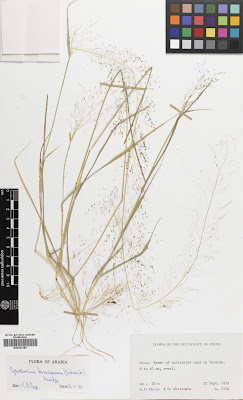
Sunday, January 29, 2012
Binomen Art - Mangrove

We were in the Galápagos Islands and we kept noticing these beautiful trees with interesting roots. Lo and behold, we were seeing mangroves! We learned that there were four principal types, and on Isabela Island in Puerto Villamil we encountered all four in front of our hotel, Hotel Sol (lat -0.9585, long -90.9645 or 0d 57’ 31” S, 90d 57’ 52” W) on December 31st , 2011. What better way is there initiate the Binomen Art series?
Rhizophora mangle - Red Mangrove is the most common mangrove, easily recognized by its stilt roots and shiny, waxy leaves. It is a true mangrove. The generic name, Rhizophora, comes from the Greek words rhiza meaning “root” and phoros meaning bearing and referring to the stilt-roots. Mangle is the Spanish name for mangrove or a thicket.
Rhizophora mangle - Red Mangrove, Puerto Villamil, Isabela Island, Galápagos


Rhizophora mangle - Red Mangrove Propagules and Spelling The Name in Sand

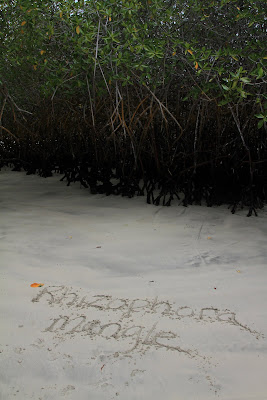
Avicennia germinans - Black Mangrove takes its common name from its grey-black bark. Another distinctive aspect is the cluster of fruits that look like lima beans with fuzzy jackets. The generic name honors the Persian physician Avicenna (980 - 1037). The specific name, germinans, is the Latin term meaning to germinate, but referring to what characteristic of this plant? After a rain shower, as shown in the before and after pictures, the seeds did look very ready to sprout.
Avicennia germinans - Black Mangrove, Puerto Villamil, Isabela Island, Galápagos
Letters spelled out with seeds and twigs

Avicennia germinans - Black Mangrove – After a Day and a Rain Shower and the Word is Sprouting

Avicennia germinans - Black Mangrove – Sprouting “A”

Avicennia germinans - Black Mangrove, the Tree that Provided the Lettering Material
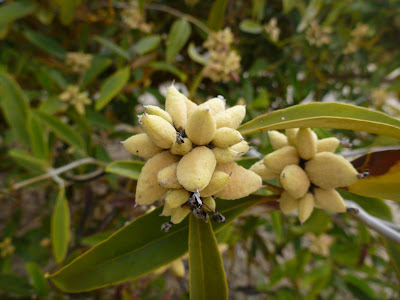
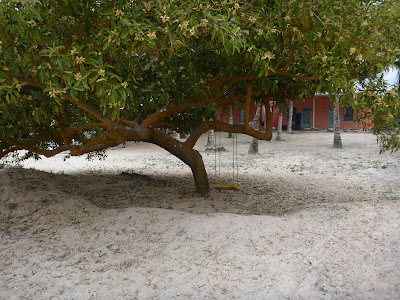

Conocarpus erectus - Button Mangrove is a mangrove that is typically found on the back of sandy beaches and that is exactly where we saw this one. It is easy to distinguish by is rounded fruits that look like buttons. The generic name, Conocarpus, comes from the Greek konos meaning “cone” and carpos meaning “fruit” referring to the cone-shaped fruit.
Conocarpus erectus – Button Mangrove, Puerto Villamil, Isabela Island, Galápagos
Letters spelled out with collected “buttons”
 Conocarpus erectus – Button Mangrove, the Buttons Up Close on the Tree That Provided the Lettering Material
Conocarpus erectus – Button Mangrove, the Buttons Up Close on the Tree That Provided the Lettering Material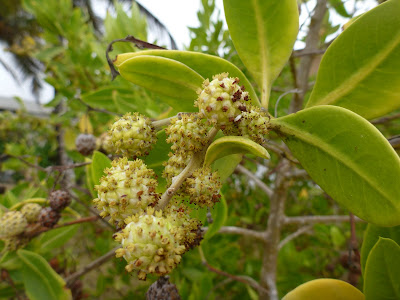

Laguncularia racemosa - White Mangrove’s generic name comes from the Latin laguncula meaning “small flask or bottle”. This Laguncularia racemosa fact sheet form the University of Florida states that laguncularia refers the shape of the white mangrove’s fruit and that the specific name, racemosa, or “cluster” refers to the growth pattern of the fruits in racemes.
Laguncularia racemosa – White Mangrove, Puerto Villamil, Isabela Island, Galápagos
Letters spelled out with seaweed and found beach objects

Laguncularia racemosa, Leaves and Flowers and Small Plant on a Beach
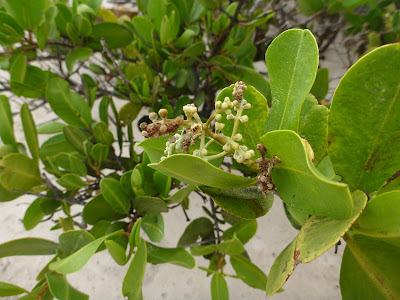
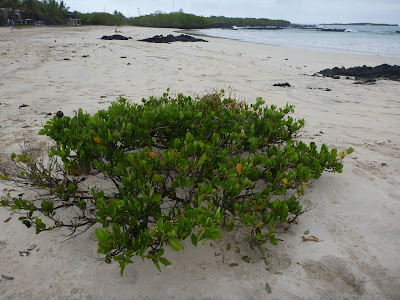
The approximate order of mangroves you can expect to see starting from the water’s edge and walking inland is red, white, black, and button mangrove. Red, black, and white mangroves reproduce using propagules which are new plants that grow on the parent and then become detached. Red mangrove propagules look like long beans and these we did see. We did not see the propagules for black and white mangrove. For more information, see Reproductive Strategies of Mangroves. The propagules are perfect for dropping in the water and floating away to root on some distant beach.
Comparison of Mangrove Leaves, Puerto Villamil, Isabela Island, Galápagos
From Left to Right: Button, White, Black, and Red


Saturday, January 28, 2012
Seattle Downtown Mural - Echoes of Sylvester?


We’ve walked by this mural several times and we immediately think of Sylvester (1947 - 1988), the talented disco diva of the 1970s and 1980s. Or maybe it is just the 1980s-like look of this mural.
The mural is located in a parking lot near the Paramount Theater in downtown Seattle at the corner of Pine and 9th. Looking back through Google maps the mural didn’t always grace this wall.
Sylvester’s album cover for the 1982 single Do You Wanna Funk captures the spirit of the mural.
The mural was executed by 404era and ksera.
The Mural Location – Before the Mural (Image from maps.google.com, left) and Today (right)


Sylvester – Original Hits Album Cover

City Flyers


Mural Attribution (left), Empty Lot on a Monday Evening (right)


Straight From Tha Sewer




The Face


Saturday, January 21, 2012
Etta James and Macklemore
Requiescat in pace, Etta James (1938 - 2012). Listening to The Sweetest Peaches - The Chess Years Part One, the 1961 single Something’s Got a Hold On Me came on and we had a whoa! moment. Is that the same opening hook used on Flo Rida’s track Good Feeling (2021)? Yes it is. We knew that opening riff was classy when we heard it in spin class at LA Fitness in Ballard.
Speaking of reuse, in the same spin class we first heard the Macklemore track And We Danced (video). We may be the only people in the world who will acknowledge this, but is that song not a bit of an homage to Disco Tex & The Sex-o-Lettes and the songs I Wanna Dance Wit’ Choo (video) or Get Dancin’ (video)?
Disco Tex: “My chiffon is wet, darling, my chiffon is wet. My wig is wet, I am tired. I can tell you I am lost in all this, I'm overwhelmed, my darling.”
Macklemore: “I will not, I will not give a damn who watches me. I will live, I will live liberate the fox in me. I will be the disco ball, freak and give my all. To whatever girl's booty I'm freaking on.”
You be the judge.
Friday, January 20, 2012
Quito - Old Town Street Vendors and All Those Doll Outfits
Street Scenes in Quito – Ice Cream on the Go, Micro-Candy Shops, Eggs, and All Those Dolls

As we mentioned in a previous post, it seems like you can buy almost anything in Quito old town right on the sidewalk. First, there are what we call the peripatetic vendors. They sell things to eat, lottery tickets, or reading material for example. Women in indigenous garb might have a baby in a sling on their back, holding another child by the hand, and holding a bowl of avocadoes in the other hand - avocadoes for sale. Want some fresh pineapple? Just stay still for a minute or so and someone will surely walk by offering it. Ice cream or something that looks like ice cream? Sure, two women are chatting as they carry mounds of it in Tupperware containers. The cones stuck in the top of the mounds give a clue.
The next type of vendor are the little shops set up in the “unused” spaces on the sidewalk. A small nook where, say, a church façade meets another structure is just the space to set up a micro-candy shop selling just a few types of candy and maybe newspapers. Sometimes it’s an old women dozing in front of a small display of various fruits.
The next level up the shopping chain is the stores in the old town. There are some larger stores, but by far, most store fronts are shoebox-sized shops selling merchandise not much different than the shop on the next street over. In particular, we puzzled over the candy stores that had huge sacks of animal crackers. Who buys those? The egg store, yes, we can understand that, but animal crackers?
But surely, the most puzzling item for sale everywhere - and we mean everywhere - were little “doll” outfits. It’s as if everyone in Quito has dolls that needed to look like kings and queens. It baffled us. We had a hunch and we confirmed with our hotel staff. These are outfits for the baby Jesus that each home or business has in its customized altar. (Approximately 95% of Ecuadorians are Catholics.)The baby is dressed for different occasions and sometimes passed to friends or relatives (god parents) to “watch” for the year. Wow that’s a babysitting chore!
Baby Jesus Altar – La Casona de la Ronda
When we were in the Fundación Guayasamín, we accidently stumbled into a tour of Guayasamín’s colonial collection of religious art. It was a tour in Spanish. We smiled and nodded, understanding about half of it. But what we did get out of it is that articulated religious figures were often produced to be able to dress them in different outfits. It is cool and festive when you think about it. The Guayasamín’s collection had a more or less life-sized Mary torso that had quite the range of motion. All the better to slip into something more comfortable.
Women Selling Fruit on the Sidewalk – Quito
Small Shops Selling Crackers, Baby Jesus Outfits, Eggs, Party Supplies – Quito
Note Dozing Fruit Vendor Over this Dazed Tourist’s Right Shoulder

















